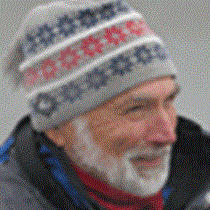San Juan and Saltspring Islands
We awoke just off American Camp on San Juan Island. This area is now a National Historic Park, because this end of the island was once used by U.S. troops in a border dispute with Canada. The conflict was over the sovereignty of the islands. A foreign pig was either shot in the field of U.S. farm or a British pig was shot in a squatter’s farm.
Mist and overcast appeared now and then but never stayed for long. Most of us were able to spend time on the bow viewing an array of wildlife. Dalls porpoises rolled through the water as rhinoceros auklets and pigeon guillemots took flight to avoid our ship.
We cruised by Spieden Island and found a group of six bald eagles on a carcass. Most of them were immature birds that quickly scattered when the only adult flew in. Spieden Island was once called Safari Island because non-native animals were brought there to be hunted. After watching the eagles we found two groups of Mouflon sheep and a small herd of exotic deer.
During the afternoon we docked at Saltspring Island for a visit to the home of Robert and Birgit Bateman. Robert Bateman needs little introduction. He is the most skilled and productive wildlife artist living today. The Batemans have had a long association with the Lindblad family and have joined us on many trips. Because of this friendship we were lucky enough to be able to visit their incredible home and studio where much of Robert’s work has been created. He was born in Toronto in 1930 and taught art and geography in high school for 20 years. He knew he would be an artist at 12 years old and has followed that love to this day. He has a large show in the near future so shared all of his new work with us. He is showing one of those paintings in today’s photo. Robert not only captured the essence of the animals but also brought us into the emotional feeling those animals convey.
Their home is part museum, part family history, and a study in how to make a house part of the landscape. Streams and pools flow with you as you walk their entry path, trees seem to meld into the posts and beams of their structure, and the views take you out into the sound. Birgit’s fiber art adds exciting variety and charm. Your gaze can run from home to trees through the intertidal to the sea that stretches to the next island. You can be inside and outside pleasantly confused in the transition.
Later in the afternoon we wound through the Gulf Islands. Harbor seals foraged along the sides of Active Pass as we passed into the Strait of Georgia. We had a fantastic sunset with the Gulf Islands backlit by glowing mist from a golden light.
We awoke just off American Camp on San Juan Island. This area is now a National Historic Park, because this end of the island was once used by U.S. troops in a border dispute with Canada. The conflict was over the sovereignty of the islands. A foreign pig was either shot in the field of U.S. farm or a British pig was shot in a squatter’s farm.
Mist and overcast appeared now and then but never stayed for long. Most of us were able to spend time on the bow viewing an array of wildlife. Dalls porpoises rolled through the water as rhinoceros auklets and pigeon guillemots took flight to avoid our ship.
We cruised by Spieden Island and found a group of six bald eagles on a carcass. Most of them were immature birds that quickly scattered when the only adult flew in. Spieden Island was once called Safari Island because non-native animals were brought there to be hunted. After watching the eagles we found two groups of Mouflon sheep and a small herd of exotic deer.
During the afternoon we docked at Saltspring Island for a visit to the home of Robert and Birgit Bateman. Robert Bateman needs little introduction. He is the most skilled and productive wildlife artist living today. The Batemans have had a long association with the Lindblad family and have joined us on many trips. Because of this friendship we were lucky enough to be able to visit their incredible home and studio where much of Robert’s work has been created. He was born in Toronto in 1930 and taught art and geography in high school for 20 years. He knew he would be an artist at 12 years old and has followed that love to this day. He has a large show in the near future so shared all of his new work with us. He is showing one of those paintings in today’s photo. Robert not only captured the essence of the animals but also brought us into the emotional feeling those animals convey.
Their home is part museum, part family history, and a study in how to make a house part of the landscape. Streams and pools flow with you as you walk their entry path, trees seem to meld into the posts and beams of their structure, and the views take you out into the sound. Birgit’s fiber art adds exciting variety and charm. Your gaze can run from home to trees through the intertidal to the sea that stretches to the next island. You can be inside and outside pleasantly confused in the transition.
Later in the afternoon we wound through the Gulf Islands. Harbor seals foraged along the sides of Active Pass as we passed into the Strait of Georgia. We had a fantastic sunset with the Gulf Islands backlit by glowing mist from a golden light.




